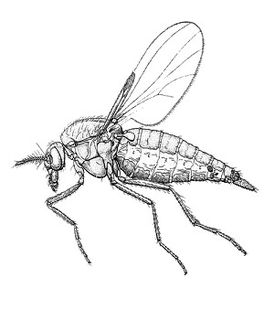
Chaoboridae, commonly known as phantom midges or glassworms, is a family of fairly common midges with a cosmopolitan distribution. They are closely related to the Corethrellidae and Chironomidae; the adults are differentiated through peculiarities in wing venation.

Culicoides is a genus of biting midges in the family Ceratopogonidae. There are over 1000 species in the genus, which is divided into many subgenera. Several species are known to be vectors of various diseases and parasites which can affect animals. Like Leptoconops, the genus has a long fossil record, with earliest known fossils being from Burmese amber, around 99 million years old.

Corethrellidae are a family of biting midges, small flying insects belonging to the order Diptera, females of which feed on the blood of frogs. The members of the family are sometimes known as frog-biting midges. The family currently consists of just one genus, totalling 115 extant and 10 fossil species worldwide. Most extant species are found in the lower latitudes, usually associated around the tropics.
Corethrella is a genus of midges that are classified in the family Corethrellidae.
Cladotanytarsus is a genus of European non-biting midges in the subfamily Chironominae of the bloodworm family Chironomidae.

Tanytarsini is a tribe of midges in the non-biting midge family (Chironomidae).

Leptoconops is a midge genus in the family Ceratopogonidae. It has a mostly tropical or subtropical distribution worldwide, but some species occur as far north as Moscow region in Russia and the Yukon Territory in Canada.
Gilka Machado (1893–1980) was a Brazilian poet and political activist. She became known as one of the first women to write erotic poetry in Brazil; her work is usually classified as symbolist. Machado was also one of the founders of the Partido Republicano Feminino in 1910,which advocated for the women's right to vote.
Robert E. Gilka was an American photojournalist best known for being an editor and director of photography at National Geographic for 27 years (1958–1985).

Atrichopogon is a genus of biting midges, small flies in the family Ceratopogonidae.

New Jersey Amber, sometimes called Raritan amber, is amber found in the Raritan and Magothy Formations of the Central Atlantic (Eastern) coast of the United States. The amber is dated to be of Late Cretaceous, Turonian age, based on pollen analysis of the host formations. The amber has been known since the nineteenth century, with several of the old clay-pit sites now producing many amber specimens for study. A number of organism fossils have been described from inclusions in the amber, including fungi, plants, tardigrades, insects, and feathers. The first identified Cretaceous age ant was described from a fossil found in New Jersey in 1966.
Leptoconops zherikhini is an extinct species of biting midges belonging to the family Ceratopogonidae. This species was described from fossilized remains preserved in Lower Cretaceous amber from Álava, Spain. These fossils represents the earliest known occurrence of extant genus Leptoconops.
Leptoconops burmiticus is an extinct species of biting midges belonging to the family Ceratopogonidae. This species was described from fossilized remains preserved in Burmese amber from the Lower Cretaceous. The amber containing the fossil was mined in the Hukawng Valley, Myanmar.
Leptoconops myanmaricus is an extinct species of biting midges belonging to the family Ceratopogonidae. This species was described from fossilized remains preserved in Burmese amber from the Cenomanian. The amber containing the fossil was mined in the Hukawng Valley, Myanmar.
Leptoconops rossi is an extinct species of biting midges belonging to the family Ceratopogonidae. This species was described from fossilized remains preserved in Burmese amber from the Lower Cretaceous. The amber containing the fossil was mined in the Hukawng Valley, Myanmar.
Phaenobezzia is a genus of biting midges in the family Ceratopogonidae. There are more than 20 described species in Phaenobezzia.
Allohelea is a genus of predaceous midges in the family Ceratopogonidae. There are more than 30 described species in Allohelea.

Heteromyia is a genus of biting midges in the family Ceratopogonidae. There are about 17 described species in Heteromyia.
Anabremia is a genus of gall midge in the family Cecidomyiidae.
Burmese amber is fossil resin dating to the early Late Cretaceous Cenomanian age recovered from deposits in the Hukawng Valley of northern Myanmar. It is known for being one of the most diverse Cretaceous age amber paleobiotas, containing rich arthropod fossils, along with uncommon vertebrate fossils and even rare marine inclusions. A mostly complete list of all taxa described up until 2018 can be found in Ross 2018; its supplement Ross 2019b covers most of 2019.







